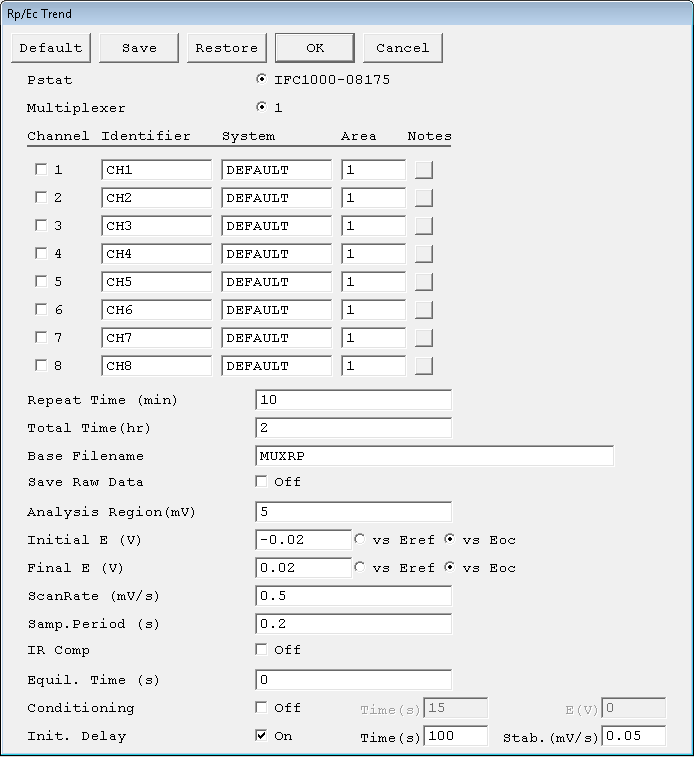Multiplexed Rp/Ec Trend Setup Parameters
Here is the Multiplexed RpEc Setup dialog box complete with its default parameters.

Select the PStat and Multiplexer using the labeled radio buttons. You may choose only one device of each type. Devices that are not available are grayed out.
NOTE: The multiplexer and potentiostat that you select must be connected together!
There is one channel setup switch for each of the eight channels. When channel switch N is selected, an X appears in the checkbox for that channel. As the script loops through the channels, it only run tests on channels that are selected. The numbers for selected channels need not be continuous.
The Identifier string is nearly identical to the Test Identifier string in DC Corrosion software. The only difference is that in multiplexed DC Corrosion the Identifier string refers to an experiment on one channel, not to the entire experimental run.
The electrode area used in calculations. Each channel can have a different area. Notes The Notes selection is similar to that used in DC Corrosion software. There is, however, a separate notes entry for each channel in a multiplexed experiment. System Selects a set of electrochemical parameters relevant to your particular test system. The parameters are recovered from the system parameter database file. The recovered parameters are all used in the calculation of corrosion rate. They are the sample’s equivalent weight, density, anodic β and cathodic β.When you attempt to run an experiment, the system searches the SYSTEM.SET file for a parameter set stored under the System name. If no parameter set is found, an error message is displayed and you are returned to the Setup dialog box. Repeat Time The time between each loop through the channels. For example, if the first loop begins at 2:08 and the Repeat Time is 30 minutes, additional loops start at 2:38, 3:08, 3:38, etc. If the test time is relatively constant, the time between tests on a single channel will be close to the Repeat Time. The Repeat Time is always entered in minutes. Enter fractional minutes as decimal numbers. The Repeat Time must be longer than the time required to run a single test. When you click the OK button in the Setup dialog box, the script estimates the time required to run one test. If this time is close to or longer than the entered Repeat Time, the Framework generates an error box and returns you to the Setup dialog box. Total Time The duration of the experiment. The script keeps track of elapsed time since the start of the experiment. Before each test, this time is compared to the Total Time. If the elapsed time is greater than or equal to the Total Time, the experiment is terminated.The Total Time is always entered in hours. Fractional hours can be entered as decimal numbers. If you want to run one test on each cell you can enter a Total Time equal to the Repeat Time. If you want N tests on each cell, enter a Total Time equal to N times the Repeat Time. A Total Time of zero results in no tests being run. Base Filename Each channel has its own data file. The Base Filename is used to derive the filenames for these files. The filename for channel N (1–8) is created by appending the character N to the Base Filename, then adding a .DTA filename extension. For example, if the Base Filename is MYMUXDATA, the data file for channel 1 is named MYMUXDATA1.DTA.The filename resulting from the concatenation of the Base Filename and the channel number must adhere to Windows®filename conventions. Avoid punctuation characters (but the underscore, “_”, is OK). You are allowed a maximum of 250 (not 255) characters in the Base Filename. The extra characters are reserved for the channel number appended to the Base Filename.Do not include .DTA when specifying the Base Filename. It is automatically added when the full data file name is generated.
Initial E, Final E, Scan Rate, Samp. Period
These parameters control the individual Rp/Ec scan. An individual Rp/Ec scan is made on each cell at each data point. The scans go from Initial E to Final E at a rate of Scan Rate mV/s. The interval between current readings is the Samp.Period.
Conditioning, Conditioning Time, Conditioning E,
Init. Delay, Delay Time, Stab.
The Conditioning and Init. Delay steps are only performed if the checkbox after the step’s name is selected. If the step is not selected, the numerical controls for that step are grayed out. On an active step, the controls (Delay Time, Stab., Conditioning Time, and Conditioning E) have their usual meanings.
CAUTION: If conditioning is selected, all ECM8 cells are conditioned. This includes non-selected channels. This includes channels not selected. This could damage electrochemical cells attached to channels that you thought would be inactive throughout the experiment.
Analysis Region The region (in mV) over which the linear fit is performed on the data. The region is bounded by X mV positive and negative from the zero current (open circuit) measurement. For example, if the sample has a zero open-circuit measurement, and the Analysis Region is 5 mV, the linear fit is performed on data from –5 mV to +5 mV.

Comments are closed.